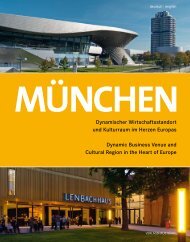München - Dynamischer Wirtschaftsstandort und Kulturraum im Herzen Europas
You also want an ePaper? Increase the reach of your titles
YUMPU automatically turns print PDFs into web optimized ePapers that Google loves.
Baukultur<br />
als Motor der Stadtgestalt<br />
Building culture<br />
as motor of the cityscape<br />
Prof. Dr.(I) Elisabeth Merk<br />
Stadtbaurätin der<br />
Landeshauptstadt <strong>München</strong><br />
Prof. Dr.(l) Elisabeth Merk<br />
Municipal Planning Councillor<br />
of the State Capital of Munich<br />
Baukultur ist ein wichtiger Motor der Stadtgestalt.<br />
Sie ist jedoch nur tauglich, wenn sie in Bewegung<br />
bleibt. Daher hat jede Generation den Auftrag,<br />
Stadtgestaltung in Bezug auf die aktuellen<br />
Bedingungen anzupassen <strong>und</strong> sie in ihrer Gestalt<br />
neu zu verhandeln. Unsere Städte müssen sich<br />
<strong>im</strong>mer wieder der Frage stellen, welcher Teil der<br />
Vergangenheit als Potenzial der Zukunft bewahrt<br />
werden soll <strong>und</strong> welcher Bereich neu definiert werden<br />
muss.<br />
Die Gestalt der alten<br />
Stadt verstärken <strong>und</strong><br />
erklären<br />
Die Dynamik der Veränderungsprozesse stellt die Bürger<br />
zunehmend vor die Aufgabe, sich mit der wandelnden<br />
Identität ihrer Städte auseinander zu setzen.<br />
Die Baukultur einer Stadt wird wesentlich durch den<br />
Städtebau, ihre Architektur sowie die Straßen <strong>und</strong><br />
Plätze best<strong>im</strong>mt. Diese Parameter prägen den unverwechselbaren<br />
Charakter einer Stadt <strong>und</strong> formen <strong>im</strong><br />
Gesamten das, was wir unter Stadtgestalt verstehen.<br />
Jede Stadt besitzt daher ihre eigene Persönlichkeit, die<br />
gekennzeichnet ist durch die Art <strong>und</strong> Weise wie Baukultur<br />
gelebt wird. Einzelne Gebäude können hervorragende<br />
architektonische Leistungen darstellen, <strong>und</strong><br />
dennoch kann es der Stadt an Gestalt mangeln. Es<br />
geht um den Bezug zum Ganzen, um die öffentlichen<br />
Räume, <strong>im</strong> gleichen Maße um die grünen Strukturen<br />
einer Stadt, um ihre Freiräume <strong>und</strong> ihre Infrastruktur-<br />
Building culture is an <strong>im</strong>portant driving force of<br />
the cityscape. But it only works if it remains in<br />
constant motion. That is why every new generation<br />
has the responsibility to adapt the design of<br />
the city to the current situation and renegotiate its<br />
look. Our cities have to repeatedly ask themselves<br />
the question, which part of history should be retained<br />
as potential for the future, and which part<br />
has to be redefined.<br />
Reinforcing and<br />
explaining the city’s<br />
design<br />
The dynamics of change are increasingly facing the<br />
citizens with the task of occupying themselves with<br />
the changing identity of their cities.<br />
The building culture of a city is largely determined by<br />
urban planning, its architecture and the roads and<br />
squares. These parameters shape the distinctive character<br />
of a city and in their totality form what we see<br />
as the cityscape. So every town has its own personality,<br />
characterised by the way the building culture is<br />
realised. Individual buildings can be outstanding architectural<br />
achievements, and yet the city can still lack<br />
structure. It is about the whole: the public areas, the<br />
green structures of a city, its spaces that can be developed<br />
and its infrastructural features. So when we<br />
speak of the quality of the city’s structure, we should<br />
really be talking about the city’s building culture.<br />
72<br />
Baukultur




